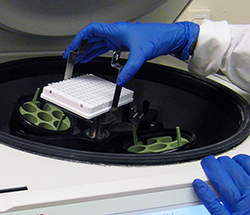
CBE Partners
In order to meet global challenges in health care, the environment, renewable energy sources, national security, and economic prosperity, the department has instituted innovative partnerships with government organizations; local industry; and other disciplines at UT, such as medical, life, physical sciences, and business. Below are the links to a few of our partner sites.
Organizations who are interested in partnering with the department should contact CBE Business Manager Amy Brewer.
External Partners
3M Company

Industry partner 3M applies science in collaborative ways to create well-known brands like Post-it, Scotch-Brite, and Filtrete, and it generously supports the department’s collaborative research projects.
Learn more
Army Research Office

The Army Research Office manages the US Army’s extramural research program, funding cutting-edge research. The office provides financial support for multiple CBE research projects.
Learn more
Center for Bioenergy Innovation

The Center for Bioenergy Innovation (CBI) is a research center within the Department of Energy’s Office of Science created to lay the scientific groundwork for a new robust, biobased economy. CBE partners with the center in research.
Learn more
Chevron Phillips Chemical

Chevron Phillips Chemical produces the chemicals that become everyday products and provides financial support for CBE’s research.
Learn more
Eastman Chemical Company

We enjoy a strong partnership with Eastman, headquartered in nearby Kingsport, Tennessee. Eastman’s recent corporate philanthropy allowed the college to renovate lab space to create the state-of-the-art Eastman Unit Operations Laboratory and the Eastman Student Commons for CBE students.
Eastman also continues to support scholarships that encourage excellence, an endowed fellowship that helps the college attract top graduate students, and gifts that support the Process-Control Lab. Additionally, UT became only the third academic partner selected to join the Eastman Innovation Network, a prestigious group of research institutions that help accelerate and develop new products that extend Eastman’s market positions. The multiyear master research agreement supports collaborative research projects in multiple disciplines, including polymer characterization, neutron science, additive manufacturing, computation, and others.
National Institute of Biomedical Imaging and Bioengineering

The mission of the National Institute of Biomedical Imaging and Bioengineering is to improve health by leading the development and accelerating the application of biomedical technologies. The Institute is committed to integrating the physical and engineering sciences with the life sciences to advance basic research and medical care and provides financial support for CBE’s research.
Oak Ridge National Laboratory

Scientists and engineers at Oak Ridge National Laboratory (ORNL) conduct basic and applied research and development to create scientific knowledge and technological solutions that strengthen the nation’s leadership in key areas of science; increase the availability of clean, abundant energy; restore and protect the environment; and contribute to national security.
Our students and faculty have access to ORNL’s advanced equipment and unique facilities in our efforts to solve some of the world’s most challenging scientific and technical problems. These resources include the Spallation Neutron Source, the world’s most powerful source of pulsed neutrons for research; the world’s fastest unclassified supercomputer; the High Flux Isotope Reactor, the highest flux reactor-based neutron source for condensed matter research in the United States; and some of the largest and most advanced additive manufacturing equipment in the world.
Internal Partners
Center for Environmental Biotechnology

The Center for Environmental Biotechnology (CEB) was established in 1986 to foster a multidisciplinary approach for training the next generation of environmental scientists and solving environmental problems through biotechnology. Over the past 22 years, CEB has distinguished itself as a world leader in developing the interdisciplinary research field of environmental biotechnology, and we are pleased to have worked closely with the center on a number of projects.
Learn more
Institute for Advanced Materials and Manufacturing

The Institute for Advanced Materials and Manufacturing, formerly the Joint Institute for Advanced Materials, builds upon a broad and growing research partnership between UT and ORNL. Together the two institutions house some of the world’s most advanced facilities in neutron scattering, nanophase materials, and high-performance computing, all of which are great resources for CBE’s materials research.
Institute for Secure and Sustainable Environment

UT’s Institute for a Secure and Sustainable Environment (ISSE) seeks to promote the development of policies, technologies, and educational programs that cut across multiple disciplines, engage the university’s research faculty and staff, and grow in response to pressing environmental and security issues facing the state, the nation, and the globe. CBE researchers have access to ISSE’s resources as appropriate.
Joint Institute for Computational Sciences

UT and ORNL established the Joint Institute for Computational Sciences (JICS) to advance scientific discovery and state-of-the-art engineering and to further knowledge of computational modeling and simulation by taking full advantage of petascale and beyond computers housed at ORNL. With support from JICS, CBE is educating a new generation of engineers well-versed in the application of computational modeling and simulation for solving the most challenging problems.
UT Institute of Agriculture

CBE often embarks on research projects in conjunction with UT’s Insitute of Agriculture, whose research seeks to make the agricultural, forest, and ornamental industries more efficient, improve the quality of rural life, and conserve soil, water, air, and wildlife.